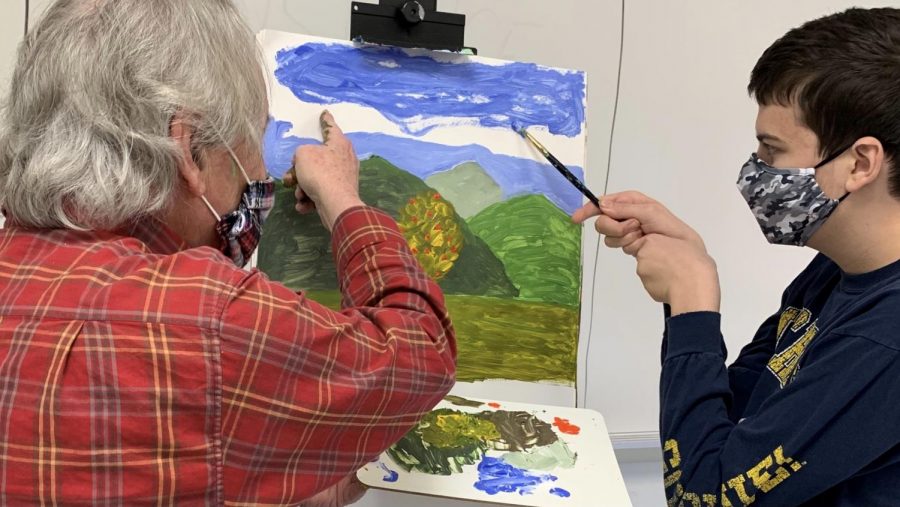During a time of unparalleled darkness, weekly freeform art classes offer students in the special education program the opportunity to to express themselves by creating beautiful pieces of artwork.
The classes are a new addition this year to the activities offered to special education students during Highlander Time. The students receive instruction in a variety of skills while painting or drawing the subject of their choice.
“Our adapted curriculum freeform art classes focus on learning, self-expression, self-confidence and having fun. I believe that every student can accomplish a lot more than he or she thinks … when it comes to art,” special education teacher John DeMers said.
The freeform classes provide students in the special education program the opportunity to pursue their artistic interests. Previously, there were limitations that prevented some students from receiving instruction in art.
“The most rewarding aspect of the class is that it offers opportunity and access to art [for] any student who wishes to participate,” Special Education Department Chair Mark Thompson said.
“Not all of the students in our program have the artistic ability to participate in the general education art classes so this class grants them the opportunity to … [participate] based on their own individual abilities.”
The freeform program was created by DeMers, who had taken many painting classes and wanted to share his passion for art with his students.
“I started painting seriously five or six years ago after a lifetime of trying seldom but wishing often,” DeMers said. “Since I’ve been taking art lessons from three very different instructors, I feel I should share what I’ve been lucky enough to learn.”
With the unusual circumstances of the pandemic, teachers have had to adjust to hosting the art classes both in person and virtually.
“The class is at its best when it is taught in person, which we have done for several weeks, and I can call kids up to paint the next thing on the canvas with a brush and acrylic paints,” DeMers said. “Taught virtually, it is the same idea but kids draw, color and paint on their own, showing us their creations on the laptop camera.”
Despite the difficulties involved in online learning, the art classes provide students with an important time to interact with their peers and teachers.
“I believe the students benefit mostly in the social interaction aspect [of the classes]. Especially nowadays, our students need some form of social interaction,” special education teacher Ariel Galo said. “It is hard to find those opportunities because we are all contained in our homes and [students] cannot see [their] classmates or talk to them.”
The classes are also an important way for students to alleviate stress resulting from virtual instruction.
“The class gives the students a break from the new norm of virtual programs and screen time to do something that is their own creation, with no right or wrong answer,” Thompson said.
Students are exposed to different aspects of art that may interest them. They are given flexibility to pursue these interests through various mediums, colors and techniques.
“Doing art whether painting, coloring, [or] drawing is a form of leisure that [students] can utilize and explore,” Galo said. “Especially now that they have free time in between classes and during asynchronous learning, they may want to explore their interests in arts, so this is an opportunity for them to learn those [skills].”
Lessons are often connected to historic events and scientific concepts.
“I plan a class around one of two things – an important piece of knowledge borrowed from history or science – or something I think the kids would like to draw, color or paint,” DeMers said. “I usually start a painting with that lesson, setting the idea, then I invite kids to come up and paint the rest as they see fit.”
The program also provides students and their teachers with the opportunity to engage and uplift one another.
“We get together and we support each other and the activity that we do [is] a vehicle for this togetherness to happen,” Galo said. “This is the most rewarding part because our students, and us teachers too, need that support; even though we are isolated physically, we can still have that sense of belonging.”









